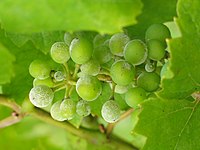Powdery mildew: Difference between revisions
→Powdery mildew of wheat: Removed superfluous link |
→Powdery mildews of various plants: apple and pear powdery mildew |
||
| Line 14: | Line 14: | ||
====Powdery mildew of onions==== |
====Powdery mildew of onions==== |
||
The fungus causing powdery mildew of onions is ''[[Leveillula taurica]]'' (also known by its anamorph name, ''Oidiopsis taurica''). It also attacks the [[artichoke]]. |
The fungus causing powdery mildew of onions is ''[[Leveillula taurica]]'' (also known by its anamorph name, ''Oidiopsis taurica''). It also attacks the [[artichoke]]. |
||
====Powdery mildew of apples and pears==== |
|||
''[[Podosphaera leucotricha]]'' is a fungus that can cause powdery mildew of [[apple]]s and [[pear]]s. |
|||
==Reproduction== |
==Reproduction== |
||
Revision as of 23:45, 10 October 2009

Powdery mildew is a fungal disease that affects a wide range of plants. Powdery mildew diseases are caused by many different species of fungi in the order Erysiphales. It is one of the easier diseases to spot, as its symptoms are quite distinctive. Infected plants display white powder-like spots on the leaves and stems. The lower leaves are the most affected, but the mildew can appear on any part of the plant that shows above the ground. As the disease progresses, the spots get larger and thicker as massive numbers of spores form, and the mildew spreads up and down the length of the plant.
Powdery mildews of various plants

Powdery mildew of grape

Erysiphe necator (or Uncinula necator) causes powdery mildew of grapes. It produces common odors such as 1-octen-3-one and (Z)-1,5-octadien-3-one.[1]
Powdery mildew of wheat
Blumeria graminis forma specialis (f. sp.) tritici, causes powdery mildew of wheat. It can persist between seasons most likely as ascospores in wheat debris left in the field. Wheat mildew thrives in cool humid conditions. Though present throughout wheat growing regions it especially favors the eastern seaboard of the United States as well as coastal regions of the United Kingdom. Controlling the disease involves eliminating conducive conditions as much as possible by altering planting density and carefully timing applications and rates of nitrogen. Since nitrogen fertilizers encourage dense leafy growth, nitrogen should be applied at precise rates to control decrease severity. Crop rotation with non-host plants is another way to keep mildew infection to a minimum, however the aerial nature of conidia and ascospore dispersal makes it of limited use. Chemical control is possible with fungicides such as triademefon and propiconazole. In addition, control of powdery mildews is possible using cultivars containing R genes (resistance genes) to prevent infection.
Powdery mildew of onions
The fungus causing powdery mildew of onions is Leveillula taurica (also known by its anamorph name, Oidiopsis taurica). It also attacks the artichoke.
Powdery mildew of apples and pears
Podosphaera leucotricha is a fungus that can cause powdery mildew of apples and pears.
Reproduction
Powdery mildew reproduces both sexually and asexually. Sexual reproduction is via chasmothecia (formerly cleistothecium), a type of ascocarp. Within each ascocarp are several ascii. Over time, ascospores mature and are released to initiate new infections. Conditions necessary for spore maturation differ between forma specialis
